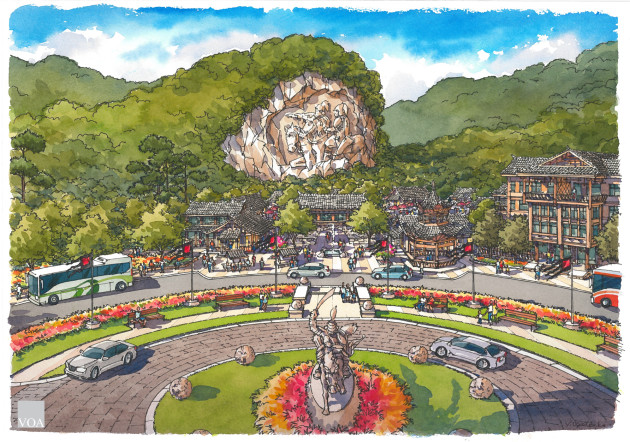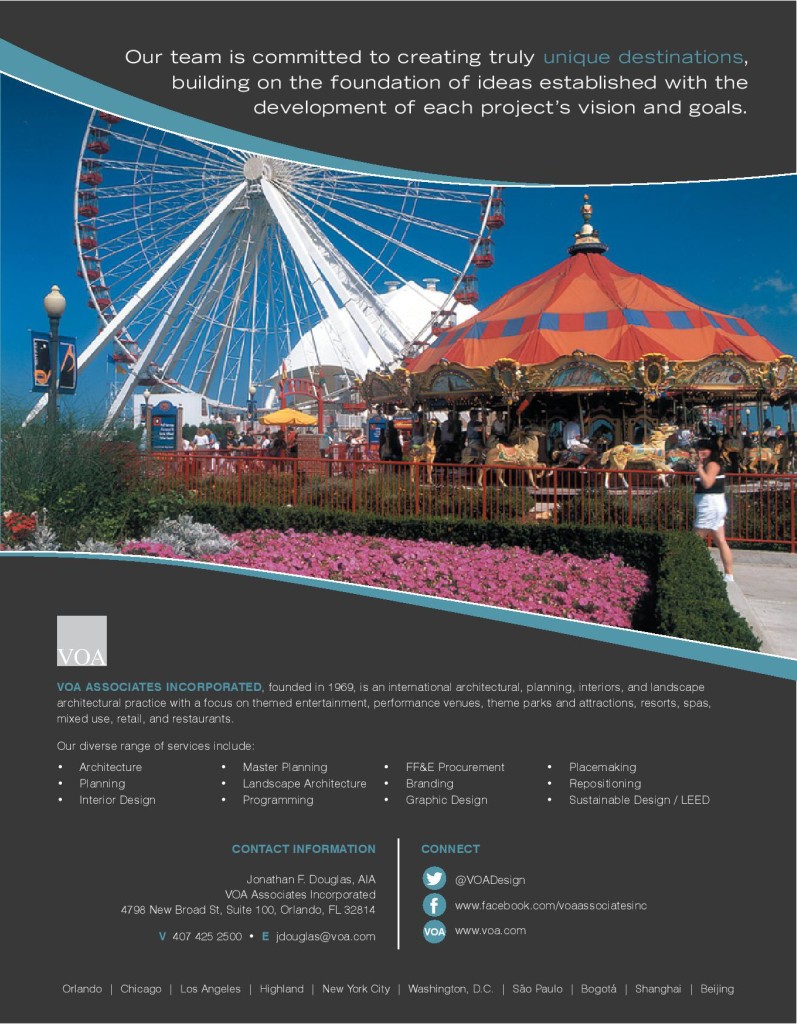ABOVE: A significant rock carving overlooking the Baisha Xi River RD&E and Visitor’s Center greets visitors to Hailongtun, China. Courtesy of VOA
Q & A with Daryl LeBlanc, AIA – Associate Principal, VOA Associates, Inc.
How does storytelling relate to entertainment design?
Storytelling is an integral part of entertainment design. Most projects have an underlying reason for being that can be expressed through stories. Whether it is creating an experience based around an IP, an educational component, or a significant culturally relevant venue, we find that stories are necessary to set the ground rules for the design. It would be problematic to define and develop the content for these projects without knowing how the story relates to the experience we are trying to convey.
What kind of projects do you employ storytelling on?
We try to incorporate storytelling into all of our projects. The most natural projects for this strategy include attractions and theme parks, museums and learning centers and RD&E [retail, dining and entertainment] venues. However, we have also found this to be an effective strategy in the design of projects within other markets, notably hotels and resorts.
How is the story developed?
This is dependent on the complexity and scale of the project. There have been occasions when we collaborate with consultants to research and write the stories, and in others, we have taken the lead for these efforts. Before design begins, an intense level of research takes place at the beginning of a project; the initial ideas are brought to the surface in a series of open discussions and workshops. Concepts, story outlines and experience fragments are discussed and debated until the ideal story for the client is developed. At that time, the actual writing begins. In some cases, this is no more than a list of several statements that comprise a series of “Goals and Outcomes” that we want all guests to experience. Other times, these “Goals and Outcomes” become expanded into a series of developed narratives that describe the experience from a guests’ point of view. The goal is to identify and describe the things we want visitors to know, feel and do.
How do you incorporate storytelling in your design process? How is it expressed?
Depending on the scope and scale of the project, the composition of the project team including the Owner, and other related factors, we typically employ a range of storytelling techniques. The design process begins with the definition of the story. This may seem strange to those who are not familiar with this process, but it can actually form the basis for a more organized and linear method of designing, especially with large, multi-disciplinary teams. When story threads, goals and outcomes are defined prior to putting pen to paper, it is easier to judge the validity of a specific design idea as we move forward. We are then asking ourselves whether this design concept now supports and enhances the story as opposed to something more subjective, such as do we like it. It is therefore easier to keep a larger team engaged and moving forward in the same direction. It is a matter of constantly asking, how does this idea/detail/material support the story. As part of this process, we develop the actual design work through techniques like storyboarding to create a series of vignettes that express how the story relates to the guest’s perspective. In some cases, we are more interested in creating a sequential series of experiences then determining practical solutions, such as where is the front door? We find that technical issues like that resolve themselves quickly leaving us time to focus on crafting the experience.
Does storytelling translate in the experience of the space? How?
I would say that these techniques do translate into the experience of the space. In some cases, this can be a very subtle overlay to what is happening, and in other cases, the story is at the forefront of how guests relate to the space. This range in story line prominence should be discussed early in the process. In either scenario, we feel that the use of stories enhance any design by making all components work together. Whether everyone fully understand the complete extent of the story at the end of their visit is more difficult to control, but they should at least get a sense that the spaces are richly textured, highly compelling and ultimately interesting enough to capture their attention and imagination, ideally making them want to return.
Will this way of approaching design continue to be important or is there something else that will replace it?
In my opinion, this method of designing will continue to be important. It is a way of distinguishing spaces and creating experiences that are more than just about developing interesting and unique forms. There is a deeper connection to the individuals that experience these spaces, and hopefully the memories created resonate longer as a result. In the future, the evolution of story-based design will include the ability for stories to be even more individualized, with the potential to be specifically tailored to each guest. While this is happening now, think of components in a museum that cater to different levels of engagement, or elements in a theme park that are meant to captivate different age groups. I believe this individualization will become more important in the future. The idea that I can have one experience in a venue that may be completely different from someone else’s yet both scenarios create the same sense of fulfillment and desire to return is a powerful notion that we should consider. I believe this extends outward past the physical environment and affect the way guests make initial plans to visit these types of spaces, which is usually via the Internet. The guest experience does not start when you arrive at a facility, it starts far earlier when we begin our planning to visit such a space. Similarly, these experiences do not stop when we leave either. It is the creation of lasting memories that are at the root of these efforts. People remember stories, especially the ones that personally involve them. Creating this highly personal connection is the reason we use stories as the basis of design and why we feel that this strategy will continue to be a strong design tool in the future.
• • •
 Since joining VOA’s Orlando office in 2002, Daryl has been instrumental in building a thriving hospitality and commercial practice, currently serving as Senior Director for VOA’s Hospitality Practice Group. He brings an exceptional expertise and knowledge base to the design and project management of complex themed entertainment environments, multi-component resorts and hotel facilities
Since joining VOA’s Orlando office in 2002, Daryl has been instrumental in building a thriving hospitality and commercial practice, currently serving as Senior Director for VOA’s Hospitality Practice Group. He brings an exceptional expertise and knowledge base to the design and project management of complex themed entertainment environments, multi-component resorts and hotel facilities







